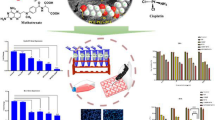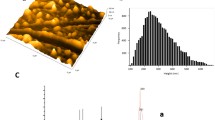Abstract
Purpose
Combined treatment based on cisplatin-loaded Poly(D,L-lactic-co-glicolic)acid (PLGA) nanoparticles (NP-C) plus the NSAID piroxicam was used as novel treatment for mesothelioma to reduce side effects related to cisplatin toxicity.
Methods
PLGA nanoparticles were prepared by double emulsion solvent evaporation method. Particle size, drug release profile and in vitro cellular uptake were characterized by TEM, DLS, LC/MS and fluorescence microscopy. MSTO-211H cell line was used to analyse NP-C biological efficacy by FACS and protein analysis.
Results
Cisplatin was encapsulated in 197 nm PLGA nanoparticles with 8.2% drug loading efficiency and 47% encapsulation efficiency. Cisplatin delivery from nanoparticles reaches 80% of total encapsulated drug in 14 days following a triphasic trend. PLGA nanoparticles in MSTO-211H cells were localized in the perinuclear space NP-C in combination with piroxicam induced apoptosis using a final cisplatin concentration 1.75 fold less than free drug. Delivered cisplatin cooperated with piroxicam in modulating cell cycle regulators as caspase-3, p53 and p21.
Conclusions
Cisplatin loaded PLGA nanoparticles plus piroxicam showed a good efficacy in exerting cytotoxic activity and inducing the same molecular apoptotic effects of the free drugs. Sustained cisplatin release allowed to use less amount of drug, decreasing toxic side effects. This novel approach could represent a new strategy for mesothelioma treatment.









Similar content being viewed by others
Abbreviations
- ACN:
-
Acetonitrile
- C:
-
Cisplatin
- C/P:
-
Cisplatin plus piroxicam
- CE:
-
Collision energy
- COX:
-
Cyclooxygenase
- CTRL:
-
Untreated cells
- DDTC:
-
Diethyldithiocarbamate
- DLS:
-
Dynamic light scattering
- DMF:
-
N,N-dimethylformamide
- DP:
-
Declustering potential
- DPH:
-
1,6-Diphenyl-1,3,5-hexatriene
- ECL:
-
Enhanced ChemiLuminescence
- EE:
-
Encapsulation efficiency
- EP:
-
Entrance potential
- FACS:
-
Fluorescence activated cell sorting
- FBS:
-
Fetal bovine serum
- FITC:
-
Fluorescein isothiocyanate
- HPLC:
-
High performance liquid chromatography
- i :
-
Cisplatin release phases
- k i :
-
Release constant value for each release phase
- LC/MS:
-
Liquid chromatography/mass spectrometry
- LE:
-
Loading efficiency
- NP:
-
PLGA-nanoparticles
- NP-C:
-
Cisplatin-loaded PLGA nanoparticles
- NP-C/P:
-
Cisplatin-loaded nanoparticles plus piroxicam
- NP-F:
-
Fluorescent PLGA nanoparticles
- NSAID:
-
Non-steroidal anti-inflammatory drug
- PBS:
-
Phosphate buffered saline
- PDI:
-
Poly dispersion index
- PI:
-
Propidium iodide
- PLGA:
-
Poly(D,L-lactic-co-glicolic)acid
- Pt-(DDTC)2 :
-
Cisplatin-DDTC derivative
- PVA:
-
Polyvinyl alcohol
- PVDF:
-
Polyvinylidene fluoride
- RCC1:
-
Regulator of chromosome condensation 1
- RIPA:
-
Radio-immunoprecipitation assay buffer
- RPMI-1640:
-
Roswell Park Memorial Institute culture medium
- SDS-PAGE:
-
Sodium dodecyl sulphate - polyacrylamide gel electrophoresis
- SIM:
-
Selected ion monitoring
- TEM:
-
Transmission electron microscopy
- TOC:
-
Total organic carbon
- w/o:
-
Water/oil
- w/o/w:
-
water/oil/water
- y i (0):
-
Cisplatin concentration at the beginning of each release phase
- y i (t):
-
Cisplatin amount released over the time
References
Treasure T. The learning curve. BMJ. 2004;329(7463):424.
Crispi S, Cardillo I, Spugnini EP, Citro G, Menegozzo S, Baldi A. Biological agents involved in malignant mesothelioma: relevance as biomarkers or therapeutic targets. Curr Cancer Drug Targets. 2010;10(1):19–26.
Pistolesi M, Rusthoven J. Malignant pleural mesothelioma: update, current management, and newer therapeutic strategies. Chest. 2004;126(4):1318–29.
Vogelzang NJ, Rusthoven JJ, Symanowski J, Denham C, Kaukel E, Ruffie P, et al. Phase III study of pemetrexed in combination with cisplatin versus cisplatin alone in patients with malignant pleural mesothelioma. J Clin Oncol. 2003;21(14):2636–44.
Favaretto AG, Aversa SM, Paccagnella A, Manzini Vde P, Palmisano V, Oniga F, et al. Gemcitabine combined with carboplatin in patients with malignant pleural mesothelioma: a multicentric phase II study. Cancer. 2003;97(11):2791–7.
Spugnini EP, Cardillo I, Verdina A, Crispi S, Saviozzi S, Calogero R, et al. Piroxicam and cisplatin in a mouse model of peritoneal mesothelioma. Clin Cancer Res. 2006;12(20 Pt 1):6133–43.
Baldi A, Piccolo MT, Boccellino MR, Donizetti A, Cardillo I, La Porta R, et al. Apoptosis induced by piroxicam plus cisplatin combined treatment is triggered by p21 in mesothelioma. PLoS ONE. 2011;6(8):e23569.
Kelland L. The resurgence of platinum-based cancer chemotherapy. Nat Rev Cancer. 2007;7(8):573–84.
Wang D, Lippard SJ. Cellular processing of platinum anticancer drugs. Nat Rev Drug Discov. 2005;4(4):307–20.
Jain RK, Stylianopoulos T. Delivering nanomedicine to solid tumors. Nat Rev Clin Oncol. 2010;7(11):653–64.
Li Y, Lim S, Ooi CP. Fabrication of cisplatin-loaded poly(lactide-co-glycolide) composite microspheres for osteosarcoma treatment. Pharm Res. 2012;29(3):756–69.
Dong Y, Feng SS. Poly(D, L-lactide-co-glycolide) (PLGA) nanoparticles prepared by high pressure homogenization for paclitaxel chemotherapy. Int J Pharm. 2007;342(1–2):208–14.
Grama C, Ankola D, MNV RK. Poly(lactide-co-glycolide) nanoparticles for peroral delivery of bioactives. Curr Opin Colloid Interface Sci. 2011;16:238–45.
Betancourt T, Brown B, Brannon-Peppas L. Doxorubicin-loaded PLGA nanoparticles by nanoprecipitation: preparation, characterization and in vitro evaluation. Nanomedicine. 2007;2(2):219–32.
Murugeshu A, Astete C, Leonardi C, Morgan T, Sabliov CM. Chitosan/PLGA particles for controlled release of alpha-tocopherol in the GI tract via oral administration. Nanomedicine. 2011;6(9):1513–28.
Valencia PM, Pridgen EM, Perea B, Gadde S, Sweeney C, Kantoff PW, et al. Synergistic cytotoxicity of irinotecan and cisplatin in dual-drug targeted polymeric nanoparticles. Nanomedicine. 2013;8(5):687–98.
Vangara KK, Liu JL, Palakurthi S. Hyaluronic acid-decorated PLGA-PEG nanoparticles for targeted delivery of SN-38 to ovarian cancer. Anticancer Res. 2013;33(6):2425–34.
Zou L, Song X, Yi T, Li S, Deng H, Chen X, et al. Administration of PLGA nanoparticles carrying shRNA against focal adhesion kinase and CD44 results in enhanced antitumor effects against ovarian cancer. Cancer Gene Ther. 2013;20(4):242–50.
Sadhukha T, Prabha S. Encapsulation in Nanoparticles Improves Anti-cancer Efficacy of Carboplatin. AAPS PharmSciTech. 2014
Tang Q, Wang Y, Huang R, You Q, Wang G, Chen Y, et al. Preparation of anti-tumor nanoparticle and its inhibition to peritoneal dissemination of colon cancer. PLoS ONE. 2014;9(6):e98455.
Pinon-Segundo E, Nava-Arzaluz MG, Lechuga-Ballesteros D. Pharmaceutical polymeric nanoparticles prepared by the double emulsion- solvent evaporation technique. Recent pat on drug deliv & formulation. 2012;6(3):224–35.
Jin C, Bai L, Wu H, Song W, Guo G, Dou K. Cytotoxicity of paclitaxel incorporated in PLGA nanoparticles on hypoxic human tumor cells. Pharm Res. 2009;26(7):1776–84.
Ranall MV, Gabrielli BG, Gonda TJ. High-content imaging of neutral lipid droplets with 1,6-diphenylhexatriene. BioTechniques. 2011;51(1):35–6, 8–42.
Strober W. Trypan blue exclusion test of cell viability. Curr Protoc Immunol. 2001; Appendix 3: Appendix 3B.
Li P, Nijhawan D, Budihardjo I, Srinivasula SM, Ahmad M, Alnemri ES, et al. Cytochrome c and dATP-dependent formation of Apaf-1/caspase-9 complex initiates an apoptotic protease cascade. Cell. 1997;91(4):479–89.
Piccolo MT, Crispi S. The dual role played by p21 May influence the apoptotic or anti-apoptotic fate in cancer. J of Cancer Res Updat. 2012;1:189–202.
Bala I, Hariharan S, Kumar MN. PLGA nanoparticles in drug delivery: the state of the art. Crit Rev Ther Drug Carrier Syst. 2004;21(5):387–422.
Merisko-Liversidge EM, Liversidge GG. Drug nanoparticles: formulating poorly water-soluble compounds. Toxicol Pathol. 2008;36(1):43–8.
De Jong WH, Borm PJ. Drug delivery and nanoparticles:applications and hazards. Int J Nanomedicine. 2008;3(2):133–49.
Spugnini EP, Crispi S, Scarabello A, Caruso G, Citro G, Baldi A. Piroxicam and intracavitary platinum-based chemotherapy for the treatment of advanced mesothelioma in pets: preliminary observations. J of exp & clin cancer res : CR. 2008;27:6.
Gao Y, Chen L, Gu W, Xi Y, Lin L, Li Y. Targeted nanoassembly loaded with docetaxel improves intracellular drug delivery and efficacy in murine breast cancer model. Mol Pharm. 2008;5(6):1044–54.
Huang M, Ma Z, Khor E, Lim LY. Uptake of FITC-chitosan nanoparticles by A549 cells. Pharm Res. 2002;19(10):1488–94.
Mo L, Hou L, Guo D, Xiao X, Mao P, Yang X. Preparation and characterization of teniposide PLGA nanoparticles and their uptake in human glioblastoma U87MG cells. Int J Pharm. 2012;436(1–2):815–24.
Cummings BS, Schnellmann RG. Cisplatin-induced renal cell apoptosis: caspase 3-dependent and -independent pathways. The J of pharmacol and exp ther. 2002;302(1):8–17.
Ferraro-Peyret C, Quemeneur L, Flacher M, Revillard JP, Genestier L. Caspase-independent phosphatidylserine exposure during apoptosis of primary T lymphocytes. J Immunol. 2002;169(9):4805–10.
el-Deiry WS, Tokino T, Velculescu VE, Levy DB, Parsons R, Trent JM, et al. WAF1, a potential mediator of p53 tumor suppression. Cell. 1993;75(4):817–25.
Vousden KH, Lu X. Live or let die: the cell’s response to p53. Nat Rev Cancer. 2002;2(8):594–604.
Cheng L, Jin C, Lv W, Ding Q, Han X. Developing a highly stable PLGA-mPEG nanoparticle loaded with cisplatin for chemotherapy of ovarian cancer. PLoS ONE. 2011;6(9):e25433.
Gryparis EC, Hatziapostolou M, Papadimitriou E, Avgoustakis K. Anticancer activity of cisplatin-loaded PLGA-mPEG nanoparticles on LNCaP prostate cancer cells. Eur J Pharm Biopharm. 2007;67(1):1–8.
ACKNOWLEDGMENTS AND DISCLOSURES
We thank INBB for supporting Dr. Maria Teresa Piccolo and Dr. Ciro Menale with fellowships; Dr. Laura Pisapia for helping in FACS analysis; Dr. Rosarita Tatè for helping in microscopy analysis; the FACS and the IM IGB Facilities. We thank Prof. Maria Rosaria Chiummo for help in the revision of the manuscript. We also thank the Neapolitan section of the IIT, in particular Dr. RaffaeleVecchione, for using Zetasizer.
Author information
Authors and Affiliations
Corresponding authors
Additional information
Ciro Menale and Maria Teresa Piccolo equally contributed to the work.
Rights and permissions
About this article
Cite this article
Menale, C., Piccolo, M.T., Favicchia, I. et al. Efficacy of Piroxicam Plus Cisplatin-Loaded PLGA Nanoparticles in Inducing Apoptosis in Mesothelioma Cells. Pharm Res 32, 362–374 (2015). https://doi.org/10.1007/s11095-014-1467-3
Received:
Accepted:
Published:
Issue Date:
DOI: https://doi.org/10.1007/s11095-014-1467-3




